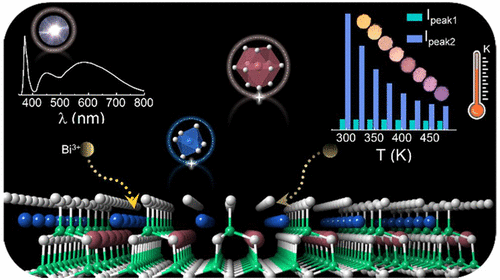当前位置:
X-MOL 学术
›
Chem. Mater.
›
论文详情
Our official English website, www.x-mol.net, welcomes your
feedback! (Note: you will need to create a separate account there.)
Yellow/Orange-Emitting ABZn2Ga2O7:Bi3+(A = Ca, Sr; B = Ba, Sr) Phosphors: Optical Temperature Sensing and White Light-Emitting Diode Applications
Chemistry of Materials ( IF 7.2 ) Pub Date : 2020-03-09 , DOI: 10.1021/acs.chemmater.0c00054 Dongjie Liu 1, 2 , Xiaohan Yun 3 , Peipei Dang 1, 2 , Hongzhou Lian 1 , Mengmeng Shang 4 , Guogang Li 3 , Jun Lin 1, 5
Chemistry of Materials ( IF 7.2 ) Pub Date : 2020-03-09 , DOI: 10.1021/acs.chemmater.0c00054 Dongjie Liu 1, 2 , Xiaohan Yun 3 , Peipei Dang 1, 2 , Hongzhou Lian 1 , Mengmeng Shang 4 , Guogang Li 3 , Jun Lin 1, 5
Affiliation

|
Recently, there has been growing interest in developing Bi3+-activated luminescence materials for optoelectronic applications. Herein, new yellow/orange-emitting ABZn2Ga2O7:Bi3+ (ABZGO, A = Ca, Sr; B = Ba, Sr) phosphors with tunable optical properties are synthesized by an alkaline earth cation substitution. When Sr2+ substitutes Ca2+ and Ba2+, the excitation wavelength has a red shift from 325 to 363 nm, matching well with the n-UV chip based white light-emitting diodes (WLEDs). CaBaZn2Ga2O7:0.01Bi3+ (CBZGO:0.01Bi3+) exhibits two evident emission peaks at 570 and 393 nm originating from the respective occupation of Ca and Ba sites by Bi3+ ions. The optical tuning of the CBZGO:Bi3+ phosphor is achieved by changing the Bi3+ doping content and excitation wavelength based on the selected site occupation. Differently, both SrBaZn2Ga2O7:0.01Bi3+ (SBZGO:0.01Bi3+) and Sr2Zn2Ga2O7:0.01Bi3+ (SZGO:0.01Bi3+) phosphors exhibit a single broad emission band, peaking at 600 and 577 nm, respectively. Two different Bi3+ sites are also verified respectively in SBZGO and SZGO hosts by the Gaussian fitting of the asymmetric PL spectra and lifetime analysis. The different luminescence behaviors of ABZGO:0.01Bi3+ phosphors should be ascribed to the synergistic effect of the centroid shift, crystal-field splitting, and Stokes shift. Moreover, the temperature-dependent PL spectra reveal that cation substitutions of Sr2+ for Ca2+ and Ba2+ can efficiently improve the thermal stability of ABZGO:0.01Bi3+ phosphors. In view of different thermal responses to various temperatures for two emission peaks of the CBZGO:0.01Bi3+ phosphor, an optical thermometer is designed and has a good relative sensitivity (Sr = 1.453% K–1) at 298 K. Finally, a WLED with CRI = 97.9 and CCT = 3932 K is obtained by combining SZGO:0.01Bi3+ and BAM:Eu2+ phosphors with a 370 nm n-UV chip, demonstrating that SZGO:0.01Bi3+ is an excellent yellow-orange-emitting phosphor for n-UV WLED devices. This work stimulates the exploration of optical tuning by cation substitution to obtain remarkable luminescence materials for optical temperature sensing and WLED applications.
中文翻译:

发出黄色/橙色的ABZn 2 Ga 2 O 7:Bi 3+(A = Ca,Sr; B = Ba,Sr)荧光粉:光学温度传感和白光发光二极管应用
近来,对开发用于光电应用的Bi 3+活化的发光材料的兴趣日益增长。在此,通过碱土金属阳离子取代合成具有可调的光学性质的新的发黄/橙色的ABZn 2 Ga 2 O 7:Bi 3+(ABZGO,A = Ca,Sr; B = Ba,Sr)荧光粉。当Sr 2+替代Ca 2+和Ba 2+时,激发波长从325到363 nm发生红移,与基于n-UV芯片的白光发光二极管(WLED)很好地匹配。CaBaZn 2 Ga 2 O 7:0.01Bi 3+(CBZGO:0.01Bi 3+)在570和393 nm处显示两个明显的发射峰,这是由于Bi 3+离子分别占据了Ca和Ba位。CBZGO:Bi 3+荧光粉的光学调谐是通过根据选定的位点占用改变Bi 3+的掺杂含量和激发波长来实现的。不同地,SrBaZn 2 Ga 2 O 7:0.01Bi 3+(SBZGO:0.01Bi 3+)和Sr 2 Zn 2 Ga 2 O 7:0.01Bi 3+(SZGO:0.01Bi 3+)磷光体显示出一个单一的宽发射带,分别在600和577 nm处达到峰值。通过不对称PL谱的高斯拟合和寿命分析,分别在SBZGO和SZGO主机中验证了两个不同的Bi 3+位点。ABZGO:0.01Bi 3+荧光粉的不同发光行为应归因于质心位移,晶体场分裂和斯托克斯位移的协同效应。此外,温度依赖性PL光谱表明,Sr 2+取代Ca 2+和Ba 2+的阳离子可以有效提高ABZGO:0.01Bi 3+的热稳定性。荧光粉。考虑到CBZGO:0.01Bi 3+荧光粉的两个发射峰对各种温度的不同热响应,设计了一种光学温度计,并在298 K时具有良好的相对灵敏度(S r = 1.453%K – 1)。通过将SZGO:0.01Bi 3+和BAM:Eu 2+荧光粉与370 nm n-UV芯片组合获得CRI = 97.9和CCT = 3932 K的WLED ,表明SZGO:0.01Bi 3+是一种优异的黄光-用于n-UV WLED器件的橙色发光磷光体。这项工作刺激了通过阳离子取代的光学调谐的探索,以获得用于光学温度感测和WLED应用的卓越发光材料。
更新日期:2020-04-23
中文翻译:

发出黄色/橙色的ABZn 2 Ga 2 O 7:Bi 3+(A = Ca,Sr; B = Ba,Sr)荧光粉:光学温度传感和白光发光二极管应用
近来,对开发用于光电应用的Bi 3+活化的发光材料的兴趣日益增长。在此,通过碱土金属阳离子取代合成具有可调的光学性质的新的发黄/橙色的ABZn 2 Ga 2 O 7:Bi 3+(ABZGO,A = Ca,Sr; B = Ba,Sr)荧光粉。当Sr 2+替代Ca 2+和Ba 2+时,激发波长从325到363 nm发生红移,与基于n-UV芯片的白光发光二极管(WLED)很好地匹配。CaBaZn 2 Ga 2 O 7:0.01Bi 3+(CBZGO:0.01Bi 3+)在570和393 nm处显示两个明显的发射峰,这是由于Bi 3+离子分别占据了Ca和Ba位。CBZGO:Bi 3+荧光粉的光学调谐是通过根据选定的位点占用改变Bi 3+的掺杂含量和激发波长来实现的。不同地,SrBaZn 2 Ga 2 O 7:0.01Bi 3+(SBZGO:0.01Bi 3+)和Sr 2 Zn 2 Ga 2 O 7:0.01Bi 3+(SZGO:0.01Bi 3+)磷光体显示出一个单一的宽发射带,分别在600和577 nm处达到峰值。通过不对称PL谱的高斯拟合和寿命分析,分别在SBZGO和SZGO主机中验证了两个不同的Bi 3+位点。ABZGO:0.01Bi 3+荧光粉的不同发光行为应归因于质心位移,晶体场分裂和斯托克斯位移的协同效应。此外,温度依赖性PL光谱表明,Sr 2+取代Ca 2+和Ba 2+的阳离子可以有效提高ABZGO:0.01Bi 3+的热稳定性。荧光粉。考虑到CBZGO:0.01Bi 3+荧光粉的两个发射峰对各种温度的不同热响应,设计了一种光学温度计,并在298 K时具有良好的相对灵敏度(S r = 1.453%K – 1)。通过将SZGO:0.01Bi 3+和BAM:Eu 2+荧光粉与370 nm n-UV芯片组合获得CRI = 97.9和CCT = 3932 K的WLED ,表明SZGO:0.01Bi 3+是一种优异的黄光-用于n-UV WLED器件的橙色发光磷光体。这项工作刺激了通过阳离子取代的光学调谐的探索,以获得用于光学温度感测和WLED应用的卓越发光材料。











































 京公网安备 11010802027423号
京公网安备 11010802027423号